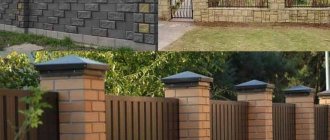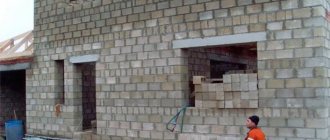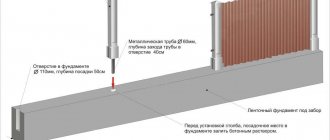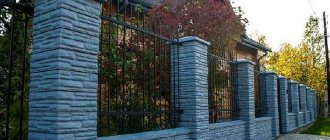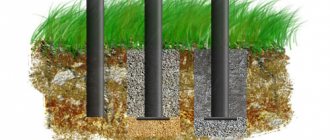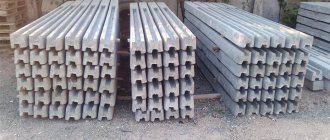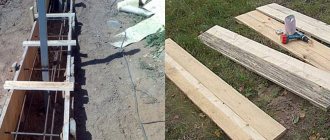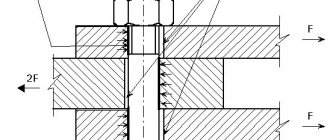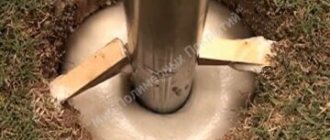When finalizing the architectural ensemble of a personal plot, fence posts are installed without concreting. There is a second option, more expensive and painstaking - placing the fence supports in a pre-prepared hole and then pouring the solution. Both methods are used in practice; each has its own advantages and disadvantages.
Is it necessary to concrete fence posts on the site?
To concrete or not - this is often one of the first questions when building fences. Not only the quality of operation of the fence structure, but also the financial costs, time and labor intensity of the process depend on the decision made. Is it necessary to concrete fence posts and when can you use other methods - we discuss the questions in the article
What factors are taken into account when choosing an installation method?
In order for the fence to stand without distortion for many years, during its construction you need to install the supports correctly. They do this using various methods. The specific one is selected depending on the height and weight of the fence, mechanical influence from the outside, wind loads on the site and other factors.
The most important criterion influencing the choice or refusal of concreting pillars is the type of soil. The main soil characteristics that should always be taken into account include:
- strength and density of the earth;
- groundwater level;
- heaving of the soil.
Peculiarities
The difference between the described method and concreting is that the compacted layer is permeable to water, that is, a drainage layer is formed at the base of the fence support, which allows moisture to pass through it. This property is the main one when determining the method of installing racks in heaving soils.
During the onset of frost, the water in the ground freezes and begins to expand. After backfilling, the support layer does not contain any extraneous moisture, and therefore it does not expand.
Another difference is the plasticity of the base, made of crushed stone and sand. The buffer zone smoothes out the pressure of the lower layers of soil.
Concreting or driving - depending on soil type
- Loam
. This is a mixture of sand and clay, with the latter component predominating in the composition. Clay does not allow water to pass through well, but is porous. Due to this, moisture can be absorbed during heavy rains. Loam is a fairly strong soil, but also plastic, especially when moistened. If you drive a fence post to an insufficient depth, then with a high weight it may sag over time. Driving is suitable for lightweight fences and when driving to a depth of 1.5 meters or more. Concreting – if the fence is high and heavy.
- Rocky soil and permafrost
. Very hard, durable and dense soils with high bearing capacity. When installing a fence in such areas, there is no need for concreting. But driving a pole into rocky and frozen ground will also not work. Therefore, installation of screw piles is suitable here. Dry concreting is also ideal - drilling a well and then filling the hole with a fence support with a sand-gravel mixture.
- Sandy soil
. It is a composition in which more than 50% is fine sand, with a fraction of up to 5 mm. It is movable, therefore, under lateral loads, simply hammering the support will cause a roll. Concreting makes it possible to increase resistance to lateral loads by increasing the area of contact with the ground. Therefore, in sandy areas this installation method is a prerequisite.
- Sandy loam
. This is a soil that is dominated by a mixture of sand and clay. It is quite loose and mobile. If you use the installation of fence posts without concreting, then during operation there is a high risk of displacement of the sandy loam, and as a result - loosening and tilting of the entire structure, up to its fall. In this case, concreting is recommended.
- Swampy soils and peat bogs
. Viscous and mobile soils. When installing a fence post by hammering, there is a significant risk that in the near future it will begin to wobble and tilt. Concreting can solve the problem. But here it is important to additionally waterproof the hole with a glass made of roofing felt or a piece of plastic pipe.
Hammering with a piledriver
The problem of how to quickly and easily drive fence posts, regardless of the financial component, is solved by using a piledriver. The principle of operation and purpose of the structure is impact technology for driving piles, supports, pillars, etc. into the ground. Using a pile driver, drive the support into the ground, and maintaining its vertical position will not be difficult.
Copier installations can be used in different versions. Hand-held pile drivers are mobile and relatively light, but a person cannot work with them alone; an assistant is needed to install the post in the initial position for driving.
Clogging a pipe with a pile driverSource ytimg.com
Mechanical self-propelled pile drivers are heavy equipment. With its help, you can not only drive poles, but also drag the support to the place of driving, install it in a vertical position before driving, and also dismantle old fences.
The time required for driving fence supports using a pile driver, even in large volumes, is minimal. In just one shift, you can install posts on a fence with a length of more than 100 meters along the perimeter. But the work is not cheap.
Knowing all the subtleties and nuances of how to hammer in fence pipes with your own hands, using available materials, you can find the optimal way to hammer in supports, taking into account the price and expected quality of work. The strength and reliability of the fence depend on proper installation, durability on the preparatory work performed, and aesthetics on the accuracy of the installation.
Heaving and its influence on the method of installing a fence post
Frost heaving of the soil occurs when moisture in the soil freezes and expands as a result.
Heaving forces act vertically on the lower part of the installed column - the heel or concrete foundation. It doesn’t matter whether you concrete the pillars for a corrugated fence or hammer them in. If you lay the support to the freezing level, with the maximum probability it will sag or fall after the first winter.
To prevent such a result, building codes give direct instructions - to lay a fence post with or without concreting exclusively below the soil freezing depth. The minimum value of the additional depth of the post is 20 cm. If you do not know where this line is located in the region where the fence is being built, then you can look at the average value in the standards SNiP SP 22.13330.2011 or its newer version - SNiP SP 22.13330.2016.
Examples of soil freezing level values in different regions are as follows:
- For Moscow and the Moscow region, the values are 1.2-1.44 m. Drive or pour concrete to a depth of 1.4 m.
- Rostov-on-Don - from 0.66 to 0.86 m. Hammer or concrete - from 1.06 m.
- St. Petersburg - from 0.98 to 1.28 m. Hammer or fill with concrete mixture to a depth of 1.18 m.
Concreting fence posts and high groundwater levels
Groundwater is a factor invisible to the eye that can affect the reliability of operation of the building envelope. In most cases, the groundwater level is located quite deep. Still, there are many areas where water flows underground at a depth of less than 1.5 meters.
The impact of high groundwater levels on fence posts is obvious. Where the stand is installed, water gradually washes away the soil. The support begins to loosen. Over time, a distortion appears. The situation is aggravated by the presence of strong side winds falling on solid sections, like corrugated fences.
If the groundwater level is high, it is necessary to install a column below the groundwater level. It is allowed to use concreting and driving methods. The choice should be based on soil characteristics.
Concrete pillars are still better suited. Due to the foundation:
- the weight and area of contact with the soil increase;
- the durability and load-bearing capacity of supports increases;
- metal corrosion is prevented;
- the service life of the fence increases.
When filling a hole under a post with concrete, it is recommended to equip it with a waterproofing jacket. Roofing felt or any similar rolled waterproofing is suitable for this. Installing a fence post in a glass made of plastic water pipe is also widely used.
If the groundwater level is too high, it is necessary to make drainage to remove moisture from under the concrete foundation. To do this, a trench is dug at a short distance along the entire enclosing structure. Excess moisture from the ground will fall into it.
Marking operation
Before you start concreting the area for the fence, you need to mark the future fence with your own hands.
The step between the pillars should be within 2.5 meters. This is due to the fact that with a solid fence, windage may occur, which will reduce the reliability of the fence. Therefore, it is necessary to maintain the installation step of the pillars within this limit.
Fence post location drawing
The bottom of a hole dug to a certain depth is carefully compacted. Then a 15 cm layer of sand is poured. The walls are insulated, for which they use rolled roofing felt, which is rolled up into a tube, and then inserted into the finished pit and carefully straightened out along the walls.
How to concrete support fence posts
Concreting is the most durable way to install fence supports. The method is especially recommended if a small-section metal pipe is chosen as a rack. Due to the concrete foundation, the contact area with the ground increases. The stand can withstand lateral loads much easier and does not loosen or sag.
Complete concreting of corrugated fence posts should be carried out in compliance with the following recommendations:
- The hole is drilled to the calculated depth. The characteristics of the soil, its level of freezing, and groundwater level are taken into account. For drilling, a hand or motor drill is better suited. This will allow you to get the exact diameter. Subsequently, concrete consumption is saved.
- The diameter of the hole for the fence post is selected taking into account the size of the support itself. It should be 2-2.5 more. If you have a metal round pipe with a diameter of 57 mm, then the size of the well should be from 114 mm to 142 mm. The smaller the pit, the less consumable material will be used for concreting installation. A larger foundation size strengthens the structure.
- A small layer of sand and crushed stone is laid out at the bottom of the pit. This cushion is needed to drain groundwater lower into the soil.
- Waterproofing is installed on the walls - a shirt made of roofing material or a glass from a piece of plastic pipe
- The pole is installed and aligned vertically. For fixation, a small layer of crushed stone is poured into the lower part of the hole. Next it is compacted.
- Concrete is being poured. It must be poured with a concrete mixture with grade strength M300. You can also use cement-sand mortar. Cement must be of a grade no lower than M400.
Required tools and materials
The technology is extremely simple, so the tools and materials needed are the simplest:
- shovel for digging a hole;
- tape measure and plumb line to check the verticality of the post;
- scrap or logs for tamping;
- bucket with water;
- gully sand.
You can fill the hole with crushed stone, gravel, or limestone.
Material for backfilling pillars
You need to approach the issue of choosing crushed stone more carefully. According to GOST, the minimum permissible stone size should be 5 mm, and the minimum permissible strength should be M200. In addition, you need to take into account the frost resistance of the material - at least F250.
The following breeds are used:
- Granite crushed stone – provides resistance to load-bearing loads.
- Limestone - obtained from sedimentary calcium rocks. Less durable, therefore it is used for backfilling only wooden poles.
- Gravel is obtained by sifting quarry soil. It is somewhat inferior in density to granite.
- Concrete crushed stone - made by recycling old concrete structures. This material is recommended for use on marshy soils and loams.
Brick fragments are often used. However, such a mixture obtained by hand is rarely homogeneous.
Partial concreting of a fence post
The fence support under a corrugated board fence can be concreted partially or halfway. The method allows you to save money on the purchase of consumables. It is preferable when installing fencing on strong, stationary soils.
You can partially fill the hole with concrete as follows:
- By analogy with full concreting, work is carried out to dig a hole with the same characteristics.
- It is worth installing waterproofing on the walls - roofing felt or plastic pipe.
- At 40-50%, the hole must be filled with crushed stone and sand. The mixture is compacted, and as it does so it is moistened. Moisture allows the layer to be compressed better.
- Concrete is poured into the remaining space. The solution should be thick enough. It is worth adding crushed stone to the composition. After filling, it is necessary to displace the air. This is done using a metal rod.
What is better to use?
On heaving soil, do not use mortar, since direct exposure to liquid will lead to destruction.
On heaving soils, you should not concrete the supports - in the spring the earth will bring them to the surface. This is a consequence of a natural phenomenon, like the transition of water from one state of aggregation to another. When soil moisture freezes, it increases in volume. In spring, the water melts and the ground begins to subside. Under the direct influence of liquid, concrete begins to collapse.
On hard ground, it is better to hammer in the supports, but on soil with a sandy or sandy-clay structure, it is more advisable to carry out concreting. Hammering poles is considered a quick and cost-effective method of installation, which is why it is used for the construction of temporary non-permanent fencing.

